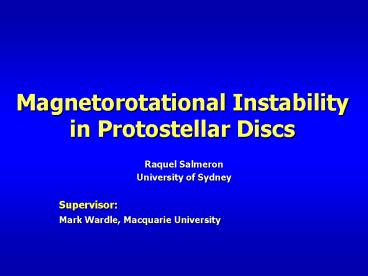Magnetorotational Instability in Protostellar Discs - PowerPoint PPT Presentation
1 / 29
Title:
Magnetorotational Instability in Protostellar Discs
Description:
Convective turbulence (Lin & Papaloizou 1980, Ryu & Goodman 1992, ... Ampere's Law. Ohm's Law. Conservation of momentum. Disc Model. Vertical Stratification ... – PowerPoint PPT presentation
Number of Views:39
Avg rating:3.0/5.0
Title: Magnetorotational Instability in Protostellar Discs
1
Magnetorotational Instability in Protostellar
Discs
- Raquel Salmeron
- University of Sydney
- Supervisor
- Mark Wardle, Macquarie University
2
Introduction
The Orion Nebula
- Low mass YSOs
- Accretion discs lt 10 Mstar
- Size up to 1000 AU
- Temperature from 10K to a few 103 K
- Weakly ionised
- Magnetically driven accretion
Hubble Space Telescope Credit C.R. O'Dell (Rice
University), and NASA
3
(No Transcript)
4
(No Transcript)
5
Accretion processes
- Angular momentum transport
- Molecular viscosity (Pringle 1981)
- Convective turbulence (Lin Papaloizou 1980, Ryu
Goodman 1992, Stone Balbus 1996) - Outflows (Wardle Königl 1993)
- Tidal effects (Vishniac Diamond 1989)
- Hydromagnetic instabilities
- Magnetorotational Instability (Balbus Hawley
1991) - Non-ideal MHD conditions
- Resistive approximation
- Ambipolar diffusion
- Hall effect
6
How the MRI transfers angular momentum outwards
- Two fluid elements, in the same orbit, are joined
by a field line (Bo). The tension in the line is
negligible. - If they are perturbed, the line is stretched and
develops tension.
- The tension acts to reduce the angular momentum
of m1 and increase that of m2. This further
increases the tension and the process runs
away.
7
Ideal MRI - An overview
- Requirements
- Angular velocity decreasing with radius
- Subthermal B with a poloidal component
- ? Satisfied in astrophysical discs
- Fastest growing modes
- growth rate
- independent of B
- wavelength proportional to B
- horizontal displacements
8
The present study
Objective To model the linear growth of MRI
perturbations at different radial locations.
- Model includes
- vertical stratification
- conductivity as a tensor
- Growth depends on
- density,
- temperature,
- ionisation rate, and
- charged species
- ? conductivity
- These factors vary radially and vertically in the
disc
- Applications
- Explore unstable zones
- Analyse properties of the MRI with a z-dependent
conductivity tensor - Motivate further work
9
Governing Equations
Amperes Law
Conservation of mass
Ohms Law
Conservation of momentum
Perturbations
Induction Equation
10
Disc Model
- Vertical Stratification
- Density distribution given by
- Evaluation of the conductivity tensor
- Method of the present work
- Allows to study the structure and growth of MRI
with model parameters
11
Linearisation
- Conductivity tensor not affected by perturbations
- Equations decouple into two subsystems
- Sound waves in the vertical direction
- MHD perturbations in the plane of the disc
- Initial state
- Assumptions
Terms lt H/r neglected
12
Model Parameters
- Magnetic coupling at the midplane
- Ratio of the midplane Alfven to sound speed ?
Strength of the magnetic field at the midplane
- Ratio of the conductivity terms perpendicular to
the field ? Conductivity regime of the fluid
13
Boundary Conditions
- At the midplane
- At the surface
System solved by shooting from the midplane to
the surface to determine ? and ?E?
14
Test Models
15
Comparison with local analysis
Growth Rate (?)
Hall regime (?1Bzgt0)
Ambipolar diffusion
Good coupling
Number of Nodes
16
Typical results - structure
Mid plane
Surface
17
Conductivity Regime
?1 ?2
Hall ?1Bz gt 0
Ambipolar diffusion
?1 -?2
Hall ?1Bz lt 0
Height above mid plane (z/H)
18
Conductivity Regime
Hall regime ?1Bzgt0
Ambipolar diffusion
Radial
Radial
Amplitude of perturbations of B
Azimuthal
Azimuthal
Height above midplane
Height above midplane
19
Conductivity Regime
?ovA/cs
Height above mid plane
Log(Magnetic coupling (?o))
20
Magnetic Field Strength
Ambipolar diffusion
Radial
Amplitude of perturbations of B
vA/cs0.005 ? 0.7000
Good coupling
Height above midplane
21
Magnetic Field Strength
Hall ?1Bz gt 0
Radial
Amplitude of perturbations of B
vA/cs0.005 ? 0.7499
Good coupling
Height above midplane
22
Parameter space - Coupling
Log(Maximum growth rate ?max)
vA/cs0.1
Log(Coupling ?o)
23
Parameter space - Magnetic field
Log(Maximum growth rate ?max)
Good coupling
Log(vA/cs)
24
Parameter space - Magnetic field
Log(Maximum growth rate ?max)
Poor coupling (?02)
Log(vA/cs)
25
Implications
Full conductivity
Ambipolar diffusion
?o 0.01
? 0.2913
? 0.3728
vA/cs0.01
vA/cs0.01
Height above midplane
Height above midplane
26
Implications
- Allowing for different conductivity regimes to
dominate at different heights, it is found that - Hall effect modifies both the structure and
growth of unstable modes - The extent of the dead zone is reduced
- The growth rate is increased
- Configuration of active zones and angular
momentum transport is significantly modified by
Hall conductivity
27
Main Findings - Summary
- Global modes are a discrete subset of possible
local modes - The most unstable MRI perturbations peak at
higher vertical locations when ambipolar
diffusion dominates - At good coupling, structure and growth rate are
determined by ambipolar diffusion - At poor coupling, the Hall effect modifies both
the structure and growth rate of the
perturbations - Perturbations grow at about the ideal rate for
- Hall limit ? gt vA2/cs2
- Ambipolar Diffusion ? gt vA/cs(Wardle 1999)
28
Main Findings - Summary
- Unstable modes exist until a certain (vA/cs)max
is reached - At good coupling, (vA/cs)max ? 1 for all regimes
- At poor coupling, (vA/cs)max ? 2.9 for the Hall
(?1Bzlt0) case - At very weak fields (vA/cs lt 0.01), global
effects are less relevant and MRI growth rates
tend to local values - Including the Hall regime in the study of
dynamical processes in low conductivity discs is
essential for the understanding of accretion.
29
Work in progress
- Include a z-dependent conductivity tensor, which
takes into account cosmic x-ray ionisation. - Conduct modelling of structure and linear growth
of MRI perturbations for a range of radial
positions in low conductivity discs.































